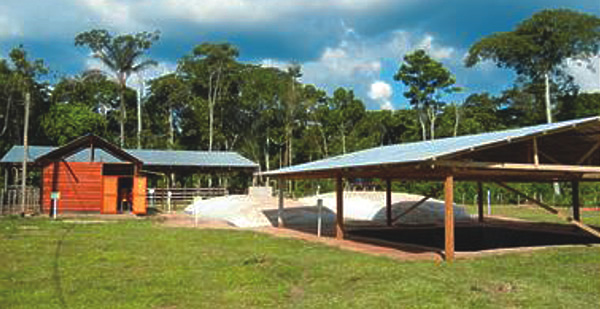Small-scale digesters around the world offer many benefits to rural communities. Some employ cooperative approaches that result in large-scale benefits across the agriculture sector.
Allison Costa
BioCycle February 2014
According to the U.S. EPA AgSTAR program, over 200 livestock facilities in the United States are employing anaerobic digestion (AD) as part of their waste management systems, with the majority of digesters on large dairy and swine farms. While many producers with smaller livestock facilities are interested in the benefits of AD systems, the economics still do not pencil out on this scale in the U.S. Internationally, however, this is not the case. Small-scale digesters around the world offer many benefits to rural communities. Some countries, such as India and China, have seen hundreds of thousands of digesters installed over the past few decades. Other countries have begun promoting AD systems in recent years with continued success. For example, in Peru, 14 percent of primary energy consumed is biogas, primarily in rural areas across the country where the biogas provides individual families with energy for cooking or lighting.
Beyond AD systems at individual homes around the world, cooperative AD projects could offer significant lessons to rural areas within the U.S. Entire communities could benefit from cheap, available energy, reduced pollution levels, and creation of jobs. Cooperative models can include small or large farms, industry groups, or community members combining their resources to realize large-scale benefits from AD projects. Recently the Global Methane Initiative (GMI) published Successful Applications of Anaerobic Digestion from Across the World, highlighting examples of rural communities benefitting from cooperative models. Following are five case studies that are in the GMI report.
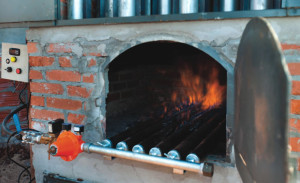
The Agro-Energy Cooperative in Parana (Brazil) uses a biogas-fueled grain dryer, which yields additional savings for the farms.
Parana, Brazil
The Agro-Energy Cooperative in Parana, Brazil, is a successful demonstration of financial gains from a biodigester demonstration project. Developed by the ITAIPU Binacional Renewable Energy Platform in the watershed of the River Ajuricaba, this project consists of a cooperative of 33 small family dairy farms that produce 16,000 tons/year of animal manure. A series of small biodigesters were installed in 2009 to collect and process the manure. The digestate is used as fertilizer on agricultural and grassland areas. Meanwhile, the biogas produced from the biodigesters is piped to a thermoelectric power plant with a gas filtration system owned by the cooperative and used to generate 438 MW hour/year of energy, including heat and electricity. The cooperative also uses a biogas-fueled grain dryer (in place of electric or gas powered grain dryers) to realize additional savings. Farmers in the cooperative receive renumeration from the energy production and benefit from a significant reduction in water pollution. They have seen a 70 percent reduction in the potential organic pollution (Chemical Organic Demand) from the digestate compared with the spread of unprocessed manure. Highlighting the significant benefits realized by collective manure processing, this project is used as a demonstration model to share its success with other small farmers in the region.
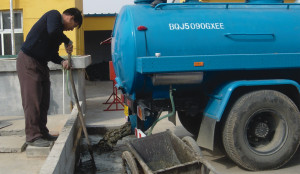
Chicken and pig manure are collected from participating farms in the Changping District (China) and brought to a central digester for processing.
Shangdongkuo Village, China
The centralized biogas supply project of Shangdongkuo Village in Changping District, Beijing, has been operating since 2008, and demonstrates the benefits of a large-scale cooperative project. Grant funding from the municipality of Beijing helped incentivize construction of this project, which involves daily collection of chicken and pig manure. The manure is transported to the biogas plant, which utilizes an upflow solids reactor digester and high-pressure gas holder to produce 207,000 cubic meters/year of biogas. The system has capacity to process 10,000 tons of manure each year. It significantly improves manure management and produces a digestate that is used as fertilizer. Besides reduced odors from decomposing manure, the biogas provides cooking fuel for 540 households in Shangdongkuo Village, demonstrating that cooperative AD systems provide benefits at all scales.
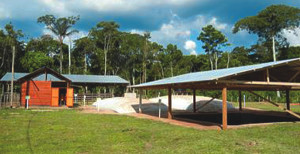
The BioSynergy digester site in Huimbayoc, San Martin (Peru) is providing 4 hours’ worth of energy daily to residents, a community center, school, clinic and church.
San Martin, Peru
The BioSynergy site in Huimbayoc, San Martin, Peru, is located far from the main electric grid and the local community had no prior access to electricity. A community of 43 families (224 people) has a small communal farm with 67 animals (cows and horses). During the day, these animals graze in the community’s fields. During the night, they are brought to a pen, where they stay for approximately 12 hours before being let out again to graze. Prior to installation of an anaerobic digester, the manure built up in the pen and was not used.
In 2012, SNV, Practical Action, Cordaid, FACT Foundation, the San Martin Regional Office of Energy and Mines, and other local entities worked together to implement a biogas project to demonstrate the feasibility of electricity generation from biomass sources in remote communities of the Peruvian Amazon for domestic, social, and productive uses. Here, access to the electrical grid is economically impossible due to high costs. Additionally, use of kerosene is forbidden because of its use in cocaine production, so people use diesel for lights. This has caused health problems within the community.
The system developed at Huimbayoc anaerobically digests manure collected from the animals’ overnight stay in the community pen and generates electricity that is designed to provide four hours’ worth of energy each day. A local grid was developed to provide this electricity to the houses. Members of the community pay for this energy at a significantly reduced fee compared to their previous spending on batteries and lighting. Electricity is also provided to the community center, school, clinic, and church. In addition, the project has changed the way the community socializes because the public areas of the town are now illuminated during the night, making it possible for local residents to engage in activities after dark.
Two jobs were created on the communal farm through this project. The community’s high level of organization facilitated creation of a management model for operating the AD system, which has been used as a demonstration to other communities for identifying relevant stakeholders, roles and responsibilities throughout the value chain in order to ensure the sustainability of similar projects.
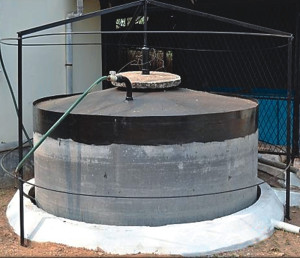
A digester installed by the Elavampadam Model Rubber Producers’ Society in Palakkad District, Kerala (India) is treating high strength wastewater from co-op members’ processing operations. The biogas offsets use of firewood to dry rubber sheets in the smoke house.
Kerala, India
The Elavampadam Model Rubber Producers’ Society in Palakkad District, Kerala, India is an example of a cooperative approach to the use of anaerobic digestion for agro-industrial purposes. More than 72 percent of the natural rubber produced in India is processed as Ribbed Smoked Sheets (RSS). For every kilogram of dry RSS produced, about 8 to 12 liters of wastewater is generated. This wastewater has high biochemical and chemical oxygen demand (BOD and COD), which can significantly reduce water quality. In Kerala, individual growers were processing latex and disposing of this wastewater without any treatment. As a result, group processing centers were organized. The significant quantities of wastewater generated by these cooperatives of individual growers are now treated anaerobically in specially designed anaerobic immobilized growth digesters.
A highly efficient and quick biomethanation technology was then designed and developed to reduce COD by 95 percent while still producing a substantial quantity of biogas. The biogas offsets the use of firewood to dry rubber sheets in the smoke house. Through implementation of the biogas recovery systems at the group processing centers, biogas provides up to 8 hours/day of drying time and has reduced use of firewood by 35 to 50 percent. Meanwhile, the anaerobically digested wastewater is taken to a diffused aerator to further reduce the pollutants to the safe limit prescribed by pollution control authorities. Sludge is then settled out of the aerated water, which is filtered and reused.
Financial assistance from the Government of India through the Rubber Board, Ministry of Commerce and Industry was used to install the effluent treatment plant. All rubber processing centers are now being encouraged to install the biomethanation system after this demonstration of the efficient and economic treatment of the effluent and generation of biogas. In addition to reduced water pollution and energy generation, the workers benefit from an esthetic and healthy environment in the processing units.
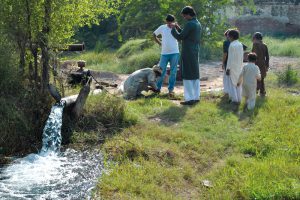
Biogas-generated electricity from a dairy manure digester in Punjab (Pakistan) is being used for water pumping at a dairy farm.
Punjab, Pakistan
Winrock International, with a grant from U.S. EPA, implemented a project in the province of Punjab, Pakistan to build the capacity of private biogas companies for installing medium-sized biogas plants. Under this project, biogas plant construction companies and dairy farmers were trained in a series of workshops on use of anaerobic digestion for cow manure to meet on-farm electricity requirements. Biogas companies received training on how to design and construct biogas plants according to specific guidelines with quality control. The farmers were trained to identify the most efficient use of the biogas produced at their site, operate and maintain the system, and record its performance. Through this cooperative approach to training, farmers understood the potential for use of anaerobic digestion to benefit their farms, increasing demand for AD systems. Simultaneously, interested companies with the requisite skills were trained to provide dependable services for implementation of quality AD systems. As a result of this project, biogas plants were constructed at the Nestle Training Center and at four private dairy farms in the region that face regular electricity shortages to offset the use of diesel, liquefied petroleum gas and fertilizer. In addition, four permanent jobs were created for plant operation and maintenance.
Each of these case studies shows how a community addressed its unique needs through implementation of anaerobic digestion systems. Far from a one-size-fits-all approach, AD systems can and should be customized for local conditions, benefitting not just individual producers, but also the broader community. These systems reduce greenhouse gas emissions, control water pollution and manage waste streams. The production of alternative and renewable energy can improve quality of life in many areas of the world. The added revenue streams and financial savings from production of biogas and commodities also create social, health and financial benefits for communities. Cooperative approaches offer opportunities for communities throughout the world to realize large-scale benefits of anaerobic digestion projects across the agriculture sector.
Allison Costa is a Co-Chair of the Global Methane Initiative Agriculture Subcommittee./em>


